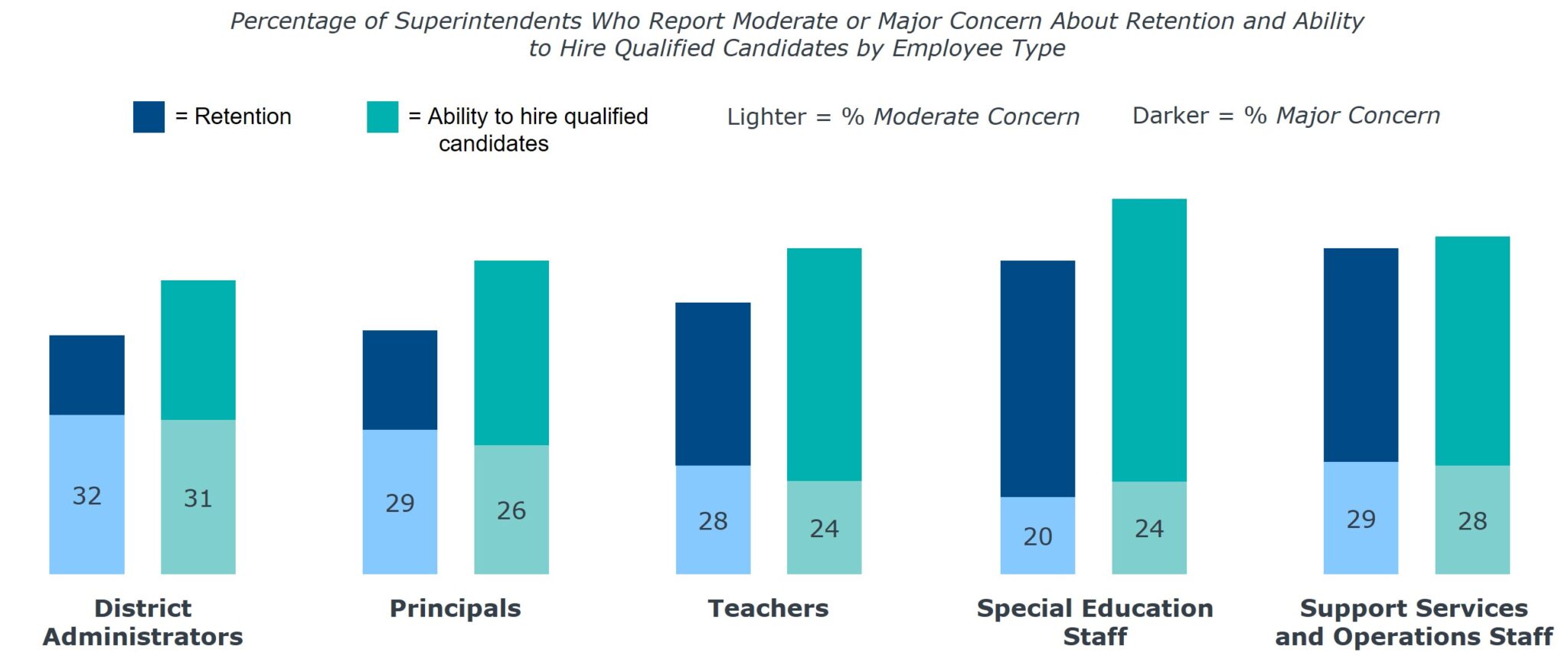The State of K-12 Staffing: Superintendents Report Nationwide Shortages in Hiring Qualified Candidates
Superintendents say their number one problem is staffing, particularly their ability to hire qualified candidates in our 2023 Voice of the Superintendent survey. This staffing challenge goes beyond teachers in the classroom. Superintendents report moderate to major concerns around hiring a variety of staff from district administrators to special education teachers to operations staff. But they report the direst need for special education staff; 73 percent of surveyed superintendents expressed major concerns about hiring these critical personnel.

While superintendents also worry about retention, their concerns about hiring outpace their level of concern about retention for all employee types. Superintendents worry the most about the retention of special education staff and support services, and operations staff, with over 80 percent of surveyed superintendents raising concerns. These concerns are unsurprising for such high-effort roles, given the widespread burnout and morale issues facing districts.
Staffing Concerns Greatest Where Needs Are Highest
Worries about staffing rose in correlation with the percentage of students who qualify for Free or Reduced-Price Lunch (FRPL). Eighty-three percent of superintendents in districts with 75 percent or more FRPL report major concerns about hiring qualified teachers. These districts are also more likely to require additional classroom support, as the likelihood of third and fourth-grade reading and math scores being a significant concern increases six-fold for districts with at least 75 percent FRPL compared to districts with fewer than 25 percent FRPL.
No Easy Solution for Staffing Concerns
High turnover and increased attention on teacher morale following the pandemic highlight the importance of finding creative staffing solutions to support the efforts of school districts nationwide. But districts face a diminishing number of new teacher candidates and financial constraints make traditional incentives like higher salaries or extra benefits unlikely solutions for most districts.
Surveyed superintendents report a wide range of tactics they intend to use, from AI to shared staffing. Nearly half of superintendents think shared staffing solutions between schools and districts will be necessary to meet their needs. Roughly the same proportion of superintendents support a more technology-driven approach, with 42 percent considering augmenting staff capabilities through artificial intelligence.
No solution rose to the top among surveyed superintendents. This lack of agreement on a clear-cut approach indicates uncertainty about the future and a need for outside-of-the-box solutions.

Creative Approaches Materializing Nationwide
Four-Day Work Week: One solution some districts are turning to is a four-day week. The number of school districts in Missouri adopting the four-day week almost doubled in the past two years. These districts see the four-day week as a tool to attract more teachers using the benefit of increased time off especially when efforts to raise teacher salaries fall short. Districts also report that four-day weeks help combat teacher burnout and improve morale.
Teacher Apprenticeships: Dallas College in Texas is partnering with local school districts to offer a first-of-its-kind teacher apprenticeship program. Participants receive a paid apprenticeship giving them a chance to gain experience and earn a salary with a partner district while still in school. This model helps support the short-term staffing needs of partner schools, while also building a robust pipeline of future educators.
High-Volume Job Fair: A Virginia school district faced a severe bus driver shortage, needing to fill 200 vacancies. In addition to an hourly pay raise and one-time bonus, they also completely rethought their hiring process. The district used a job fair as a one-stop shop to funnel candidates through applications, interviews, and health screenings in one place in a single afternoon. The process allowed them to quickly reach full staffing and the district has used the same process for other in-demand roles like paraprofessionals.
Your staffing challenges are not going away. At EAB, we help districts identify and implement proven solutions to their critical challenges, like hiring and retention. To learn more about how we provide superintendents and their teams with expert guidance and hands-on support to make meaningful change in their districts, visit us at eab.com/k12 or click here.
More Blogs

From building managers to strategic leaders

Building systems for principal success: 3 key lessons for district leadership
